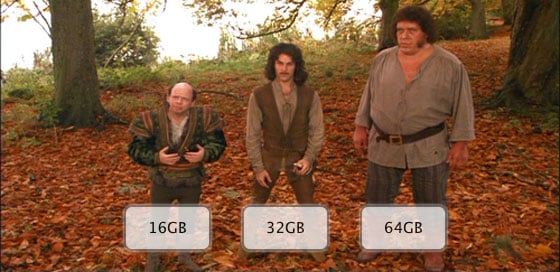
So you know you're getting an iPhone 4S, and you've chosen which carrier to get it on, now you need to decide which storage capacity you wish -- 16GB, 32GB, or 64GB?
No problem. Let's break it down, shall we?
It would be nice if we could just walk into the Apple store, find a demo iPhone 4S, and say "Siri, based on my exact needs, which size iPhone 4S should I get?" but sadly even Siri isn't that artificially intelligent... yet. There are a few things we can look at, however, to help decide.
Price for storage
The current US prices for iPhone 4, with full carrier subsidies are:
- 16GB: $199 or $12.44 a GB
- 32GB: $299 or $9.34 a GB
- 64GB: $399 or $6.23 a GB
It looks like you can pay 2x the price for 4x the storage, a pretty sweet deal, but it doesn't really work out like that. After $199, Apple is basically getting you to pay a $100 premium for an addition 16GB of storage (check out how much a 16GB SD card or thumb drive costs by way of comparison). The $200 premium for an additional 48GB of storage is more interesting if only because the double density NAND Flash Apple is using to reach that size is probably a bit more expensive for them. But $200 more expensive? (Hey, that's where Apple's fat margins come from.)
So if you're looking at this purely from a "how can I pay Apple as little as possible" perspective, the baseline 16GB model is usually the way to go. Of course, there are a lot of other factors to consider.
iCloud
iCloud promises to give us all unlimited online storage for iTunes purchased content -- iBooks, music, movies, TV shows, and apps, and 5GB of additional storage for backups, data, etc. You can also purchase more iCloud storage for the following yearly fees:
Master your iPhone in minutes
iMore offers spot-on advice and guidance from our team of experts, with decades of Apple device experience to lean on. Learn more with iMore!
- 10GB: $20/year
- 20GB: $40/year
- 50GB: $100/year
This might make it tempting to save some $$$ up front on onboard storage and make up for it with the free 5GB iCloud, with the option to buy more storage as a safety blanket.
It's not a crazy idea but it's important to remember that online storage isn't always as available, fast, and convenient as onboard storage. For example, you can't just play a movie from iCloud, you have to download it at the same time you watch it, which means you have to have enough space available on your iPhone 4S to handle the download. If you want to watch a lot of movies, you may have to watch, delete, watch, delete, over and over again.
iCloud isn't as open as things like Dropbox, so you can only really store what Apple lets you. If your movies and videos don't come from iTunes, that's an important consideration. Also, in our tests iCloud's free 5GB could get filled up pretty quickly by photos and especially videos.
Bottom line, iCloud means you can get away with managing more content on your device, but you still want to have enough local storage for what you need, when you need it.
8mp photos and 1080p video
iPhone 4S can take 8 megapixel photos and shoot 1080p video and those can be some big files. Justin Horn of When Will Apple did the math on the videos and worked out:
iPhone 4S 1080p video takes up about 2.5 times as much space as the iPhone 4. So using a more moderate estimate of keeping 60 minutes of video on your camera roll you are looking at 10.4 GB of storage vs 4.6 GB for the iPhone 4, so that can add up quick.
I take a ton of photos and videos on my iPhone 4 16GB and run out of space all the time. It's a pain in the butt to have to go through and figure out what to delete if I'm not near my computer and can't sync stuff of, so if you're really into the camera, that's something you need to consider.
Content
The other thing that can fill up our iPhone quickly is content.
- Games can be big, and with iPhone 4S' Apple A5 processor, we might see even bigger ones with more textures and richer environments. Infinity Blade is 600MB, for example. How big will Infinity Blade 2 be?
- iTunes movies can be 1-3GB in size for SD depending on the length. If you prefer watching HD, they can be 3-5GB.
- iTunes TV shows can be a quarter to half the size of movies, but more than make up for it by the number of episodes typically available.
- If you get your movies and TV shows from somewhere other than iTunes, you're still looking at about 400MB an hour for SD and over 1GB (sometimes way over) an hour for HD.
- Music files are generally quite small but can add up as well, especially if you have lots and lots of albums you want to keep with you everywhere.
Who should get 16GB
If you don't use a lot of apps, if you don't want to have a lot of movies and TV shows, or a huge amount of music, if you don't intend to shoot and keep very much 8mp photos or 1080p video on your iPhone, you'll probably be okay with 16GB.
Some people like to keep their iPhones light and do all their gaming and media on their iPad, and some people manage their photos and videos very well, transferring them to their computers regularly and reliably.
If you keep your iPhone lean, you can probably save yourself some cash and get by on 16GB.
Who should get 32GB
If the iPhone is your primary device, if you play games on it and watch movies and TV shows on it, if you have a decent sized music collection you want to keep with you, and if you shoot an average amount of photos and videos, 32GB is probably your sweet spot.
Some people like to have one device that, while it doesn't do everything all the time, it's capable enough to do most things most of the time. As long as there's some extra space to give extra time to managing apps and content, like Goldilocks it feels just right.
If you do a fair but not overwhelming amount of stuff on your iPhone, your probably better off going for 32GB.
Who should get 64GB
If you're a power user who wants to keep as much as possible for as long as possible, if you have a large amount of apps and games, TV and movies, and a huge music collection you simply have to have with you all the time, or you shoot photos and video almost non stop and don't want to have to bother transferring it all the time... we'll, you've probably been waiting for a 64GB option for a while now!
Some people really do want their iPhone to do everything, all of the time, and never (or rarely) have to worry about running out of space. They probably want 128GB -- or even 256GB if they could get it! -- but they'll use the most they can, whenever they can.
If you really feel like you need it, you probably didn't need me to tell you so, and you've already decided you're getting 64GB. Enjoy!
What if you choose the wrong size?
Remember, in most places you have time to try out your new iPhone 4S and return it if you don't like it. Make sure, as soon as possible, you put your iPhone 4S to realistic use. Load up all the apps and games you want with you, load up your movies and TV shows, go out and take some photos and shoot some video. Give it a complete and thorough workout and see.
If it feels like you got too much storage, say 64GB and you haven't even gone past 2GB, or if you got too little, say you're already at 15GB of 16GB, then take your iPhone 4S back and exchange it for one that better suits your needs.
If you come to this realization too late, after the exchange period is over, remember you can buy additional iCloud storage, or look at other options like Dropbox which will let you keep your stuff available online and potentially free up some much needed space on your iPhone.
Any questions?
If you're still not sure, hit up our iPhone 4S Forums to get the help you need to make up your mind.
Senior Editor at iMore and a practicing therapist specializing in stress and anxiety. She speaks everywhere from conferences to corporations, co-host of Vector and Isometric podcasts, follow her on Twitter @Georgia_Dow and check out her series at anxiety-videos.com.

